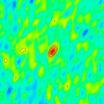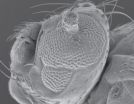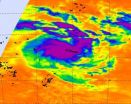(Press-News.org) WASHINGTON -- Using NASA's Hubble Space Telescope, astronomers have uncovered a previously unseen population of seven primitive galaxies that formed more than 13 billion years ago, when the universe was less than 4 percent of its present age. The deepest images to date from Hubble yield the first statistically robust sample of galaxies that tells how abundant they were close to the era when galaxies first formed.
The results are from an ambitious Hubble survey of an intensively studied patch of sky known as the Ultra Deep Field (UDF). In the 2012 campaign, called UDF12, a team of astronomers led by Richard Ellis of the California Institute of Technology in Pasadena used Hubble's Wide Field Camera 3 (WFC 3) to peer deeper into space in near-infrared light than any previous Hubble observation.
The observations were made during six weeks in August and September, and the first scientific results now are appearing in a series of scientific papers. The UDF12 team is releasing these unique data to the public after preparing them for other research groups to use.
The results show a smooth decline in the number of galaxies looking back in time to about 450 million years after the big bang. The observations support the idea galaxies assembled continuously over time and also may have provided enough radiation to reheat, or re-ionize, the universe a few hundred million years after the theorized big bang.
Looking deeper into the universe also means peering further back in time. The universe is estimated to be 13.7 billion years old. The newly discovered galaxies are seen as they looked 350 to 600 million years after the big bang. Their light is just arriving at Earth now.
Astronomers study the distant universe in near-infrared light because the expansion of space stretches ultraviolet and visible light from galaxies into infrared wavelengths, a phenomenon called "redshift." The more distant a galaxy, the higher its redshift.
The greater depth of the new Hubble images, together with a carefully designed survey strategy, allows this work to go further than previous studies, thereby providing what researchers say is the first reliable census of this epoch. Notably, one of the galaxies may be a distance record breaker, observed 380 million years after the birth of our universe in the big bang, corresponding to a redshift of 11.9.
A major goal of the new program was to determine how rapidly the number of galaxies increases over time in the early universe. This measure is the key evidence for how quickly galaxies build up their constituent stars.
"Our study has taken the subject forward in two ways," Ellis explained. "First, we have used Hubble to make longer exposures. The added depth is essential to reliably probe the early period of cosmic history. Second, we have used Hubble's available color filters very effectively to more precisely measure galaxy distances."
The team estimated the galaxy distances by studying their colors through a carefully chosen set of four filters at specific near-infrared wavelengths. "We added one filter, and undertook much deeper exposures in some filters than in earlier work, in order to convincingly reject the possibility that some of our galaxies might be foreground objects," said team member James Dunlop of the Institute for Astronomy at the University of Edinburgh in Scotland.
Astronomers have long debated whether hot stars in such early galaxies could have provided enough radiation to warm the cold hydrogen that formed soon after the big bang. This process, called "re-ionization," is thought to have occurred 200 million to 1 billion years after the birth of the universe. This process made the universe transparent to light, allowing astronomers to look far back into time. The galaxies in the new study are seen in this early epoch.
"Our data confirm re-ionization was a gradual process, occurring over several hundred million years, with galaxies slowly building up their stars and chemical elements," said Brant Robertson of the University of Arizona in Tucson. "There wasn't a single dramatic moment when galaxies formed. It was a gradual process."
The team's finding on the distant galaxy census has been accepted for publication in The Astrophysical Journal Letters.
INFORMATION:
For images and more information about these results, visit:
http://www.nasa.gov/hubble
and
http://hubblesite.org/news/2012/48
NASA'S Hubble provides first census of galaxies near cosmic dawn
2012-12-13
ELSE PRESS RELEASES FROM THIS DATE:
Building better barley
2012-12-13
As one of the top 10 barley producers in the world, Canada faces a problem of adapting to the 'new normal' of a warmer, drier climate.
The 2012 growing season was considered an average year on the Canadian Prairies, "but we still had a summer water deficit, and it is that type of condition we are trying to work with," said Scott Chang, a professor of soil science in the University of Alberta's Department of Renewable Resources in Edmonton, Canada.
Chang teamed with fellow crop scientist Anthony Anyia of Alberta Innovates – Technology Futures in 2006, following a severe ...
Mercyhurst University study probes impact of climate change on ectotherms
2012-12-13
A new study by biologists at Mercyhurst University focuses on the influence of climate change, particularly warmer winters, on the survival and potential fecundity of cold-blooded animals.
Cold blooded animals, or ectotherms, do not have an internal mechanism for regulating body temperature. Instead, they rely on solar energy captured by the environment.
The purpose of the Mercyhurst study, a collaboration of Michael Elnitsky, Ph.D., assistant professor of biology; and students Drew Spacht and Seth Pezar, is to assess the current and future impacts of climate change ...
Stress-resilience/susceptibility traced to neurons in reward circuit
2012-12-13
A specific pattern of neuronal firing in a brain reward circuit instantly rendered mice vulnerable to depression-like behavior induced by acute severe stress, a study supported by the National Institutes of Health has found. When researchers used a high-tech method to mimic the pattern, previously resilient mice instantly succumbed to a depression-like syndrome of social withdrawal and reduced pleasure-seeking – they avoided other animals and lost their sweet tooth. When the firing pattern was inhibited in vulnerable mice, they instantly became resilient.
"For the first ...
Astronomers catch jet from binge-eating black hole
2012-12-13
Back in January, a new X-ray source flared and rapidly brightened in the Andromeda galaxy (M31), located 2.5 million light-years away. Classified as an ultraluminous X-ray source (ULX), the object is only the second ever seen in M31 and became the target of an intense observing campaign by orbiting X-ray telescopes -- including NASA's Swift -- and radio observatories on the ground. These efforts resulted in the first detection of radio-emitting jets from a stellar-mass black hole outside our own galaxy.
A ULX is thought to be a binary system containing a black hole that ...
Protein strongest just before death
2012-12-13
Researchers at Michigan State University have discovered a protein that does its best work with one foot in the grave.
The study, which appears in the current issue of the Journal of Biological Chemistry, focuses on the nontraditional lifestyle of Retinoblastoma tumor suppressor proteins, which could lead to new ways to treat cancer.
"Retinoblastoma proteins are unique in that they use controlled destruction to do their jobs in a timely but restrained fashion," said Liang Zhang, a lead author and MSU cell and molecular biology graduate student. "This is an unusual way ...
Experimental agent briefly eases depression rapidly in test
2012-12-13
A drug that works through the same brain mechanism as the fast-acting antidepressant ketamine briefly improved treatment-resistant patients' depression symptoms in minutes, with minimal untoward side effects, in a clinical trial conducted by the National Institutes of Health. The experimental agent, called AZD6765, acts through the brain's glutamate chemical messenger system.
Existing antidepressants available through prescription, which work through the brain's serotonin system, take a few weeks to work, imperiling severely depressed patients, who can be at high risk ...
Study reveals new factor that could limit the life of hybrid and electric car batteries
2012-12-13
COLUMBUS, Ohio – A new study of the batteries commonly used in hybrid and electric-only cars has revealed an unexpected factor that could limit the performance of batteries currently on the road.
Researchers led by Ohio State University engineers examined used car batteries and discovered that over time lithium accumulates beyond the battery electrodes – in the "current collector," a sheet of copper which facilitates electron transfer between the electrodes and the car's electrical system.
This knowledge could aid in improving design and performance of batteries, explained ...
NASA sees newborn Tropical Storm Evan causing trouble for American Samoa
2012-12-13
The date 12-12-12 may be numerically significant, but for the residents of American Samoa and Fiji in the South Pacific Ocean, it means a newborn tropical storm named Evan is causing problems. NASA's Aqua satellite and NOAA's GOES-15 satellite both captured imagery of the newborn storm's cloud cover.
Tropical Storm Evan caused regional warnings to be posted on Dec. 12. In American Samoa, a gale warning and storm watch are in effect for Tutuila, Aunuu, Manua and Swains Island.
The Atmospheric Infrared Sounder (AIRS) instrument aboard NASA's Aqua satellite captured an ...
Ceramic indoor cookstove use did not significantly lower child pneumonia risk in rural Kenya
2012-12-13
DEERFIELD, Il. (December 11, 2012)—Inexpensive, locally-produced ceramic cookstoves may produce less smoke than traditional indoor 3-stone firepits, but they don't significantly reduce indoor air pollution or the risk of pneumonia in young children, according to results from a small, year-long observational study by researchers working in rural Kenya.
The findings, published online today in the American Journal of Tropical Medicine and Hygiene, are the first to examine the health impacts of ceramic cookstoves that do not vent smoke to the outside of the house, said Robert ...
X-ray laser takes aim at cosmic mystery
2012-12-13
An international collaboration including researchers from Lawrence Livermore National Laboratory has refined a key process in understanding extreme plasmas such as those found in the sun, stars, at the rims of black holes and galaxy clusters.
In short, the team identified a new solution to an astrophysical phenomenon through a series of laser experiments.
In the new research, appearing in the Dec. 13 edition of the journal Nature, scientists looked at highly charged iron using the Linac Coherent Light Source (LCLS) free-electron laser. Highly charged iron produces ...




